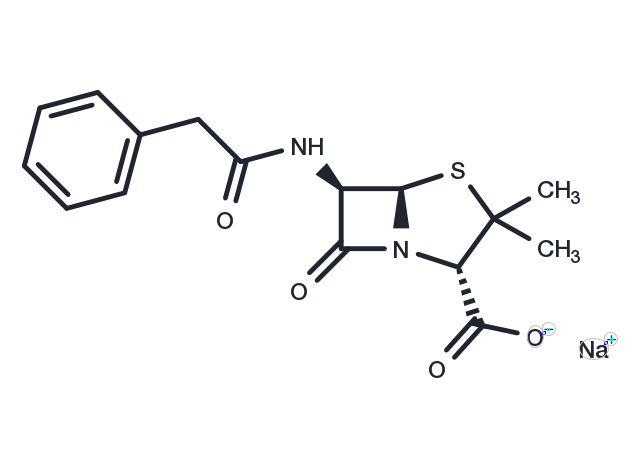Powder: -20°C for 3 years | In solvent: -80°C for 1 year


Penicillin G sodium(Benzylpenicillin sodium) salt is a penicillin derivative commonly used in the form of its sodium or potassium salts in the treatment of a variety of infections. It is effective against most gram-positive bacteria and against gram-negative cocci. It has also been used as an experimental convulsant because of its actions on GAMMA-AMINOBUTYRIC ACID mediated synaptic transmission.

| Pack Size | Availability | Price/USD | Quantity |
|---|---|---|---|
| 100 mg | In stock | $ 47.00 | |
| 200 mg | In stock | $ 68.00 | |
| 500 mg | In stock | $ 112.00 | |
| 1 mL * 10 mM (in DMSO) | In stock | $ 39.00 |


| Description | Penicillin G sodium(Benzylpenicillin sodium) salt is a penicillin derivative commonly used in the form of its sodium or potassium salts in the treatment of a variety of infections. It is effective against most gram-positive bacteria and against gram-negative cocci. It has also been used as an experimental convulsant because of its actions on GAMMA-AMINOBUTYRIC ACID mediated synaptic transmission. |
| In vitro | Benzylpenicillin is also commonly known as penicillin G. Benzylpenicillin exhibits activity mainly against Gram-positive organisms. Some Gram-negative organisms such as Neisseria gonorrhoeae and Neisseria meningitidis are also reported to be susceptible to Penicillin G. |
| Synonyms | Penicillin G Sodium, Benzylpenicillin sodium salt, Benzylpenicillin Sodium |
| Molecular Weight | 356.37 |
| Formula | C16H17N2NaO4S |
| CAS No. | 69-57-8 |
Powder: -20°C for 3 years | In solvent: -80°C for 1 year
DMSO: 66 mg/mL (185.2 mM)
H2O: 65 mg/mL (182.4 mM)
Ethanol: < 1 mg/mL (insoluble or slightly soluble)
You can also refer to dose conversion for different animals. More
bottom
Please see Inhibitor Handling Instructions for more frequently ask questions. Topics include: how to prepare stock solutions, how to store products, and cautions on cell-based assays & animal experiments, etc.
Penicillin G sodium salt 69-57-8 Membrane transporter/Ion channel Microbiology/Virology Neuroscience GABA Receptor Antibacterial Antibiotic Penicillin G Sodium inhibit Benzylpenicillin sodium salt Benzylpenicillin Inhibitor Bacterial Penicillin G Benzylpenicillin Sodium Penicillin G sodium inhibitor
